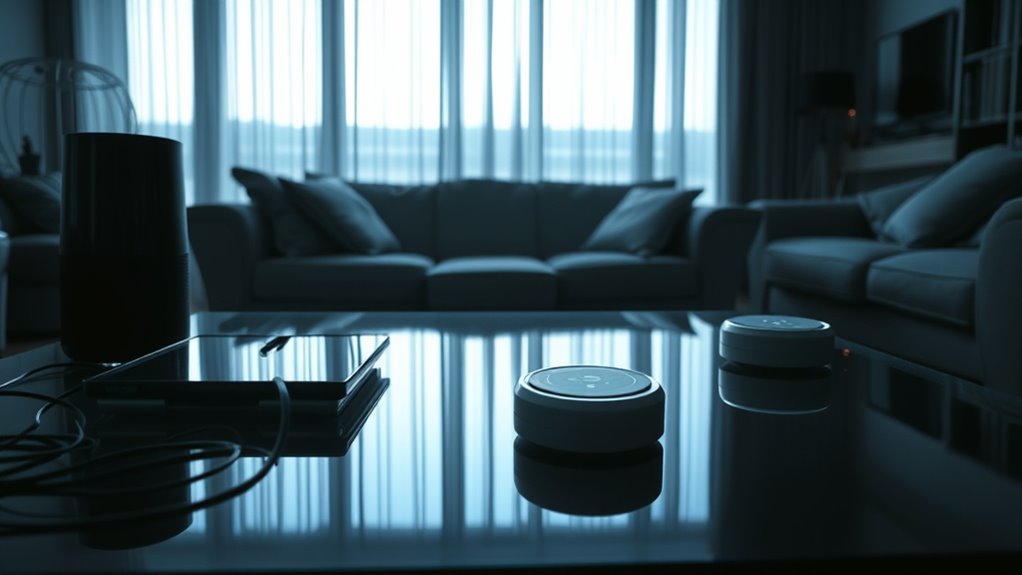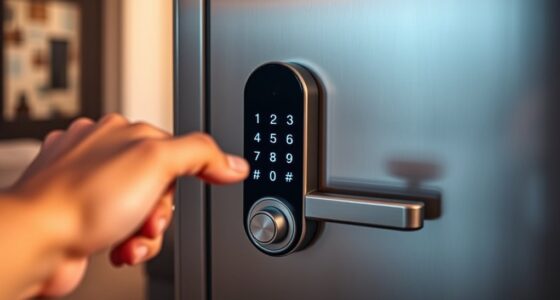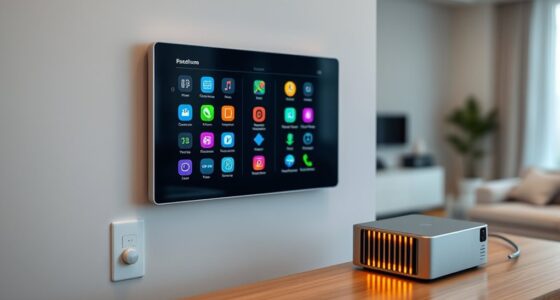Your smart home devices often come with default passwords, weak encryption, and outdated firmware, making them easy targets for hackers. Many devices share your data without your awareness, relying heavily on cloud systems and lacking local control. Poor security practices, over-permissioned apps, and default privacy settings make your personal information vulnerable. If you want to understand how to protect your privacy and tighten security in your smart home, there’s more to uncover.
Key Takeaways
- Default passwords and weak encryption expose smart home devices to hacking and unauthorized data access.
- Outdated firmware and lack of updates leave devices vulnerable to known security exploits.
- Heavy reliance on cloud services increases privacy risks and potential data breaches.
- Default privacy settings often enable automatic data sharing without user awareness or consent.
- Poor network segmentation and lack of local control make devices susceptible to lateral attacks and privacy breaches.
Default Passwords and Weak Encryption Settings
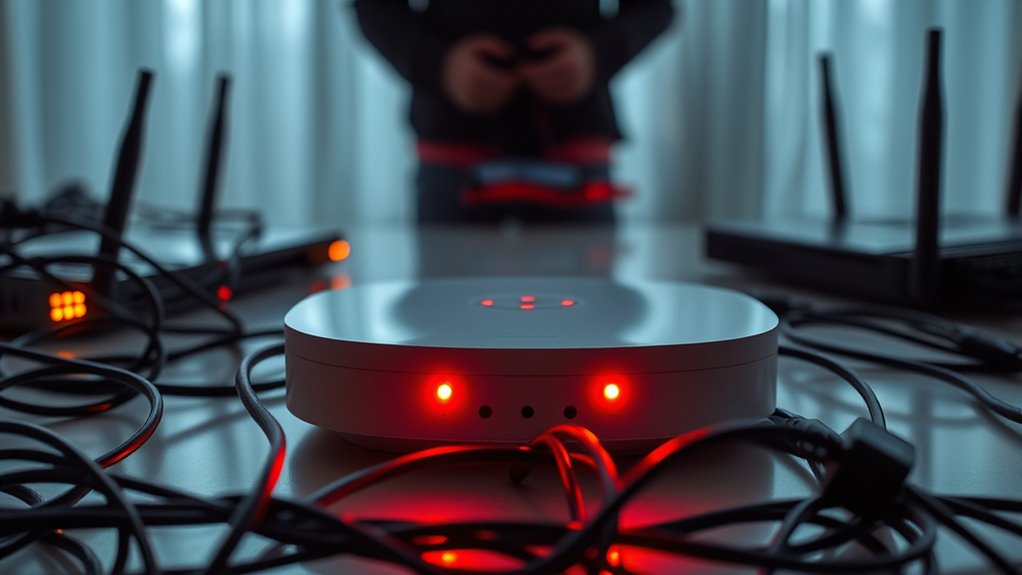
Have you ever considered how many smart home devices come with default passwords like “admin” or “password”? These default passwords are easy for hackers to guess, creating immediate security vulnerabilities. Many smart devices also rely on weak encryption or no encryption at all, making data transmissions vulnerable to interception. When manufacturers ship devices with factory-set credentials and minimal security settings, your home network becomes exposed. Over half of IoT devices keep their default credentials unchanged, increasing the risk of unauthorized access. Weak encryption combined with default passwords makes it simple for cybercriminals to hijack devices, access private data, and even compromise your entire network. This combination profoundly heightens your privacy risks, leaving your smart home vulnerable to attacks. Additionally, the lack of security awareness among consumers often means these vulnerabilities go unnoticed until a breach occurs. Regular updates and security best practices are essential to mitigate these risks and safeguard your connected devices. Being aware of default security configurations can help you take proactive steps to improve device security before an attack happens. Staying informed about cybersecurity measures can help you recognize and address potential threats before they escalate. Understanding the importance of user-specific security settings is crucial in creating a safer smart home environment.
Outdated Firmware and Lack of Security Updates
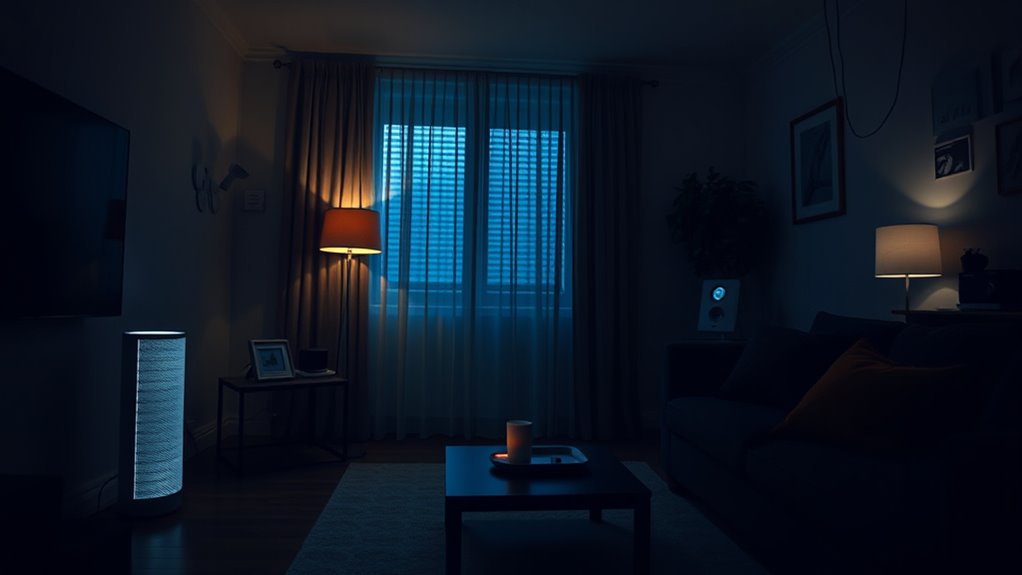
Many smart home devices run on outdated firmware because updates are often infrequent or ignored. Without the latest security patches, your devices become easy targets for hackers. Regularly checking for and installing updates is essential to keep your home protected. Incorporating security best practices such as enabling automatic updates can further reduce vulnerabilities. Additionally, vendor support policies play a crucial role in ensuring devices receive timely security updates and patches. Ensuring your devices have up-to-date firmware is vital for maintaining robust security defenses against evolving threats. Moreover, understanding the types of cookies used by device platforms can help users better manage their privacy settings and device security. Staying informed about firmware update schedules can help you anticipate and prepare for critical security enhancements.
Vulnerabilities From Outdated Firmware
Outdated firmware in your smart home devices can leave critical security vulnerabilities unpatched, making it easier for hackers to exploit known flaws. When devices run outdated firmware, they become prime targets for device hacking, as cybercriminals can leverage security vulnerabilities that haven’t been addressed through firmware updates. Many smart home devices fail to automatically install security patches, leaving these flaws exposed for long periods. Without timely firmware updates, hackers can gain unauthorized access, control devices, or even launch attacks like DDoS. Especially with low-cost or older devices, outdated firmware is common because manufacturers don’t always provide frequent updates. Staying current with firmware updates is essential to close security vulnerabilities and protect your smart home from potential intrusions. Additionally, the increasing use of Automation in Business highlights the importance of maintaining robust security measures to prevent exploitation. To ensure ongoing protection, users should regularly check for firmware updates and enable automatic updates when available. Regular firmware updates are crucial because security patches often contain fixes for newly discovered vulnerabilities, reducing potential attack vectors. Incorporating creative problem-solving approaches can also help users find innovative ways to safeguard their devices against evolving threats. Furthermore, adopting AI-powered security tools can enhance detection of unusual activity and respond more swiftly to threats.
Missed Security Patches Risk
Did you know that failing to install security patches can leave your smart home devices vulnerable? When firmware updates and security patches are missed, vulnerabilities remain unpatched, making devices easy targets. Hackers exploit outdated firmware in security cameras, smart locks, and other devices once flaws are publicly disclosed. Many users neglect firmware updates, increasing the risk of cyberattacks, malware, and unauthorized access. Manufacturers often stop providing security updates after a device’s end-of-life, leaving existing hardware exposed. Ignoring updates compromises device security and opens the door for breaches. Additionally, cybersecurity vulnerabilities can be exploited when devices remain outdated, further amplifying the risks. Regular firmware updates are essential to maintain device integrity and protect against emerging threats. Implementing secure update protocols can help ensure that updates are delivered safely and effectively. Ensuring proper device security management helps mitigate these risks and keeps your smart home safe. For example, automatic update features can help users stay protected without manual intervention. To visualize:
| Firmware Updates | Risks of Outdated Firmware |
|---|---|
| Essential for security | Vulnerabilities persist |
| Often manual | Increased cyberattack risk |
| Patch known flaws | Device security weakens |
| End-of-life support | Exposure to threats |
| Critical for protection | Data breaches possible |
Importance of Regular Updates
Regularly updating your smart home devices is vital because manufacturers often release security patches and improvements that fix known vulnerabilities. Without timely firmware updates, your devices remain exposed to security vulnerabilities that hackers can exploit. Outdated firmware leaves your smart home susceptible to hacking, giving attackers a chance to gain unauthorized access or control. Studies show many devices run outdated firmware due to neglected updates or manual settings. Installing security patches promptly ensures your devices stay protected against emerging threats. Failing to do so jeopardizes your privacy and device protection, increasing the risk of privacy breaches. Staying current with firmware updates is a simple but essential step in safeguarding your smart home from potential threats and maintaining control over your connected devices.
Vendors With Questionable Security Practices
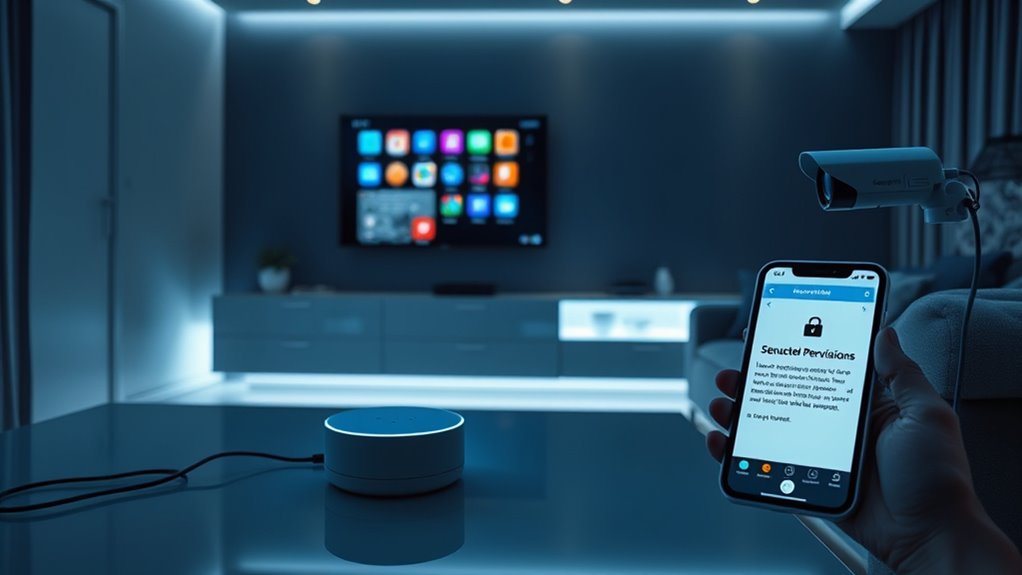
Many budget-friendly smart home device vendors cut costs by neglecting security, leaving your devices vulnerable to hackers. These vendors often provide weak default protections, making it easier for intruders to access your data. They rely heavily on cloud services, which increases privacy concerns if their servers are compromised or shut down. Many vendors share user data with third parties without clear consent, raising privacy issues. Outdated encryption standards or no encryption at all expose your data to interception. Industry reports reveal that cost-cutting often leads to default passwords, unpatched vulnerabilities, and questionable privacy policies. Here’s a quick overview:
| Vendor Practice | Security Impact |
|---|---|
| Weak default protections | Easy for hackers to access devices |
| Excessive data sharing | Privacy breaches through third parties |
| Reliance on cloud services | Increased risk if servers are compromised |
| Outdated encryption | Data interception and eavesdropping |
| Delayed security updates | Unpatched vulnerabilities, ongoing risks |
Over-Permissioned Mobile Apps and Hidden Data Sharing
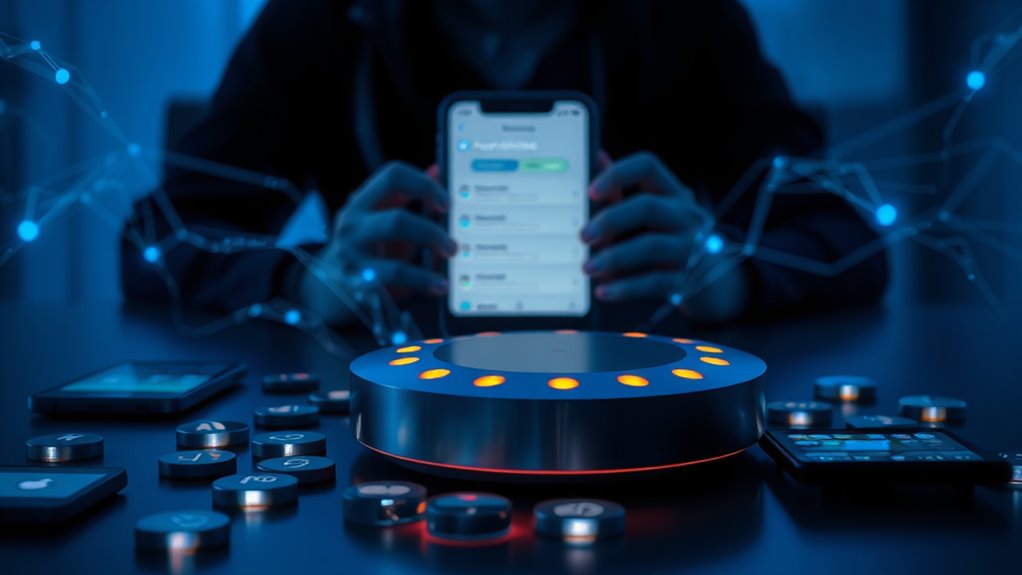
While security flaws in smart home devices often stem from poor vendor practices, another significant risk comes from the apps that control these devices. Many smart home apps request unnecessary permissions like microphone, camera, or location access, far beyond what’s needed for basic functions. Default privacy settings often enable data sharing, allowing these apps to collect and transmit your data without your knowledge. Over-permissioned apps can secretly access sensitive info, such as audio recordings or images, which might be shared with third parties or used for targeted ads. To protect your privacy, consider these steps:
- Review app permissions regularly
- Disable unnecessary permissions
- Be cautious when granting access
Doing so reduces privacy risks and lowers the chances of data breaches.
Exposed Cameras and Unsecured Video Devices

Many smart cameras and video devices come with default passwords that are easy for hackers to guess, putting your privacy at risk. If these devices aren’t properly secured or separated from your main network, they can be accessed remotely, exposing sensitive footage. Using unique passwords and network segmentation helps protect your home’s video feeds from unauthorized viewers.
Default Password Vulnerabilities
Default passwords like “admin” or “1234” are often pre-set on security cameras and video devices, making them easy for hackers to access. Leaving these default credentials unchanged exposes you to unauthorized access, risking your privacy. Many owners neglect to change passwords, leaving devices vulnerable to cyberattacks. To improve password security, consider these steps:
- Change default credentials immediately after setup.
- Enable two-factor authentication if available.
- Regularly update firmware to patch security flaws.
Weak default security settings combined with outdated firmware heighten the risk of unauthorized access and spying. Cybersecurity experts emphasize the importance of these measures to protect your video devices from malicious intruders. Taking action now can prevent privacy breaches and safeguard your smart home.
Cloud Data Exposure
Have you considered how exposed your smart cameras and video devices might be? Many unsecured devices lack proper encryption, making their data vulnerable to interception and hacking. Weak or default login credentials further increase the risk of unauthorized access, allowing cybercriminals to spy on your home. When your video footage is stored in the cloud, it faces cloud storage risks—data breaches that can expose sensitive videos during server breaches. Outdated firmware or security lapses in cloud providers can let hackers access live feeds or recordings remotely. This data exposure can lead to serious privacy violations, such as surveillance, identity theft, or extortion. Protecting your smart device security means understanding these cloud data breaches and securing your video devices from unnecessary risks.
Network Segmentation Benefits
Exposing your smart cameras and unsecured video devices to the same network as your sensitive data creates considerable security risks. By implementing network segmentation, you isolate IoT devices on a separate VLAN or Wi-Fi network, reducing the attack surface. This approach enhances your smart home security and safeguards your privacy. Consider these benefits:
- Limits hackers’ ability to move laterally from compromised cameras to critical systems.
- Prevents unauthorized access by keeping video devices separate from sensitive data.
- Simplifies managing and updating devices without risking your main network.
Proper segmentation, combined with strong passwords and firmware updates, greatly reduces vulnerabilities. This strategy shields your privacy and makes your smart home environment markedly safer from cyber threats.
Improper Network Segmentation and Device Isolation

Connecting multiple smart home devices on the same network without proper segmentation creates significant security risks. Without device isolation, hackers can exploit one compromised device to move laterally across your network, gaining access to sensitive systems like cameras or computers. Proper network segmentation, through VLANs or separate Wi-Fi networks, is essential for smart home security. Default configurations often lack this separation, making it easier for unauthorized access to occur. When devices aren’t isolated, a breach in one device can cascade to others, increasing your vulnerability. Implementing VLANs or multiple SSIDs can effectively segment your network, reducing the attack surface and preventing lateral movement. This simple step greatly enhances your privacy and protects your critical home systems from hackers.
Vulnerabilities in Cloud-Dependent Systems
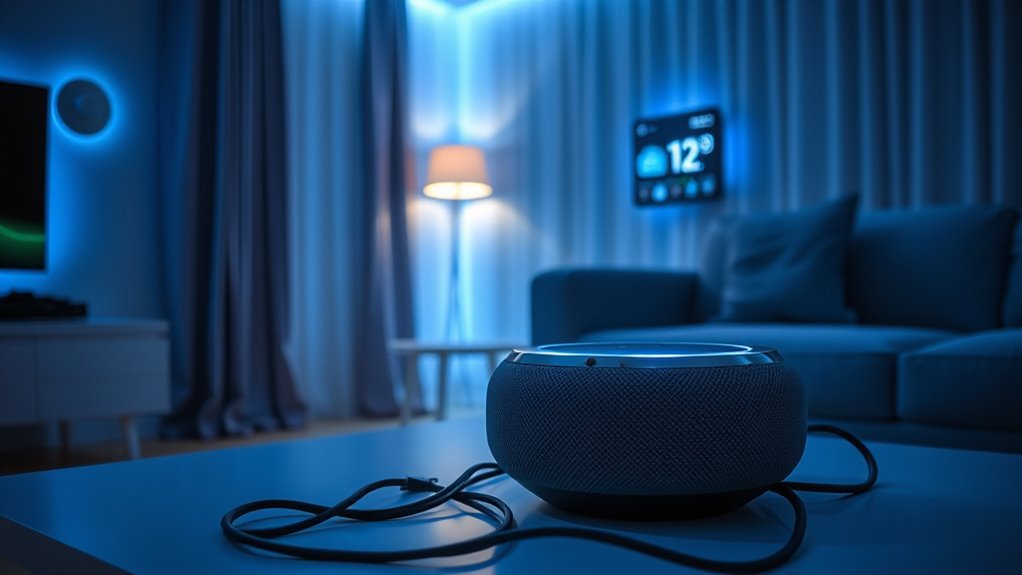
Did you know that relying on cloud-dependent smart home devices introduces significant vulnerabilities? When your devices depend entirely on third-party cloud servers, outages or server shutdowns can disable key features. You’re also exposed to privacy risks because sensitive data is transmitted to external servers, increasing the chance of data breaches and interception. Additionally, firmware vulnerabilities can go unpatched if cloud access is lost, leaving devices open to hacking. Here are three key concerns:
- Cloud dependence makes devices vulnerable to outages and server shutdowns.
- Data breaches and privacy risks grow as your personal info is stored and transmitted remotely.
- Remote access and third-party cloud reliance heighten the chances of unauthorized hacking and surveillance.
Insecure Guest Wi-Fi Networks
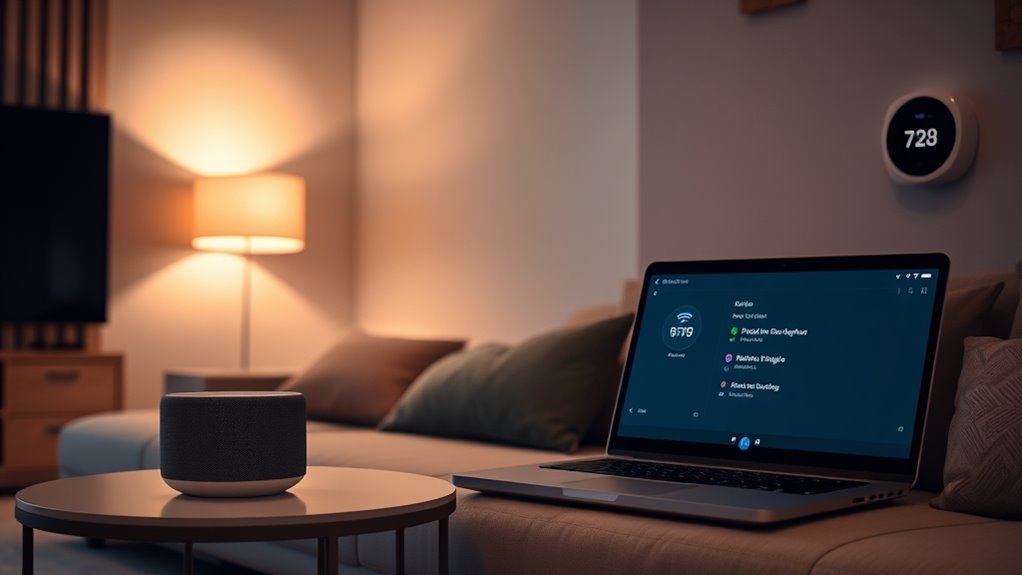
Insecure guest Wi-Fi networks pose a significant threat to your smart home security, especially when they rely on outdated encryption protocols like WEP. An unsecured network with weak or default passwords makes it easy for cybercriminals to gain unauthorized access to your guest Wi-Fi, putting your smart devices at risk. When these devices are on the same network, hackers can intercept data transmitted between them, compromising your privacy. To protect your data security, consider network segmentation by placing smart devices on a separate, secured guest network. Regularly update your Wi-Fi security settings and monitor guest network activity to prevent unauthorized access. Taking these steps minimizes vulnerabilities and helps safeguard your smart home from potential cyber threats.
Lack of Local Control and Reliance on Cloud Services

Relying solely on cloud services for smart home devices can leave you vulnerable if the vendor shuts down servers or your internet goes out. Without local control, your devices become useless during outages, risking complete loss of functionality. Additionally, cloud-dependent smart devices often transmit sensitive data through third-party servers, increasing exposure to breaches and unauthorized access. To improve your privacy and security, consider these options:
- Opt for devices with local control to manage them directly within your home network.
- Reduce reliance on cloud services, limiting data sharing and exposure.
- Be aware that internet dependence introduces security risks—if your connection drops or servers go offline, your smart home’s functionality is compromised.
Choosing devices with local control enhances data privacy, minimizes security risks, and ensures continued operation regardless of internet issues.
Default Privacy Settings and Misconfigured Controls
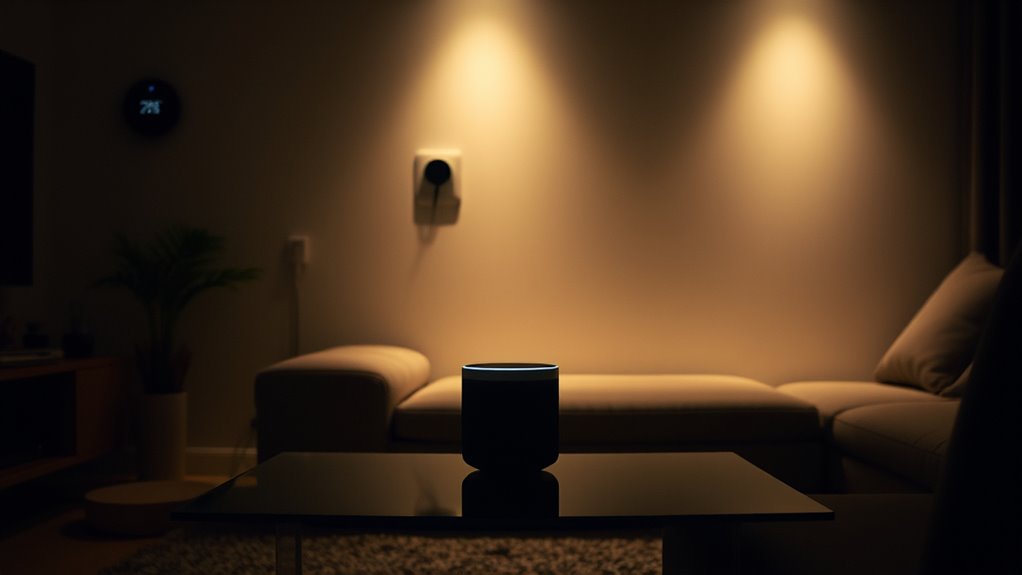
Many smart home devices come with default privacy settings that share your data automatically, often without you realizing it. If you don’t review or change these controls, your microphones, cameras, and location info could be exposed to unauthorized access. Leaving permissions enabled or using factory default passwords makes your devices vulnerable and your privacy at risk.
Default Permissions Enabled
Default permissions on smart home devices often come enabled, allowing them to share data and access sensitive features like microphones, cameras, or location without your explicit consent. This setup increases the risk of privacy breaches and exploits security vulnerabilities. You might not realize that:
- Many devices automatically share usage data with cloud servers unless you disable these options.
- Default privacy settings often grant access to sensitive info like contacts or audio without user consent.
- Unnecessary permissions granted during setup leave devices vulnerable to unauthorized access and surveillance.
These default permissions can lead to unchecked data sharing and privacy violations. Without reviewing and adjusting settings, you unintentionally expose yourself to potential privacy breaches, empowering malicious actors and compromising your security.
Privacy Settings Overlooked
Have you ever overlooked the privacy settings on your smart home devices? Many default configurations automatically enable data sharing and device permissions without your awareness or consent. Devices often upload usage data and store information in the cloud by default, increasing privacy risks unless you manually adjust these settings. Misconfigured controls, like leaving cameras or microphones unrestricted, can expose private conversations or areas. Default passwords and unsecured network permissions further heighten vulnerabilities if not changed or reviewed regularly. User awareness is essential—taking the time to review and customize your privacy settings helps protect your personal data. Ignoring these defaults leaves you exposed to potential privacy breaches, so always disable unnecessary permissions and secure your network to keep your smart home private.
Data Sharing Defaults
Did you realize that your smart home devices often come with privacy settings already turned on, sharing your data without your knowledge? Many devices have default privacy settings that enable data sharing automatically, risking your sensitive information. These default configurations frequently grant permissions for microphones, cameras, and location, exposing your data to third-party access. If you don’t change your device configuration, broad permissions and automatic data sharing can persist, even if you intend to keep your privacy intact. To stay protected, watch out for these issues:
- Default privacy settings that enable automatic data sharing.
- Permissions granted without your explicit consent.
- Third-party access to sensitive information through misconfigured controls.
Frequently Asked Questions
Are Smart Home Devices Invading Your Privacy?
You might wonder if your smart home devices invade your privacy, and the answer is yes, they can. Many devices come with weak passwords and outdated security, making it easy for hackers to access your data. They often share your voice commands, videos, and habits with third parties without consent. To protect yourself, change default settings, use strong passwords, and stay aware of what data your devices collect and share.
How Do I Stop My Smart Home From Spying on Me?
You’re right to be cautious about your smart home’s secrets. To stop it from spying on you, start by changing default passwords and disabling features like microphones and cameras you don’t use. Regularly review privacy settings, keep your device firmware updated, and create a separate Wi-Fi network for your smart gadgets. Opt for devices with local controls and strong encryption to keep your privacy safe and sound.
What Are the Negative Effects of Smart Homes?
You might face negative effects like compromised privacy, as smart devices collect and share personal data without you realizing it. Security risks increase if you don’t update firmware or use weak passwords, making your home vulnerable to hackers. Relying on cloud services can lead to data breaches or loss of control if servers go down. Additionally, exposed cameras and microphones can invite unauthorized surveillance, invading your privacy and safety.
Which Two Hidden Security Risks Can Come With Using Smart Devices?
When you use smart devices, two hidden security risks are often overlooked. First, default passwords can be easily guessed or hacked, giving intruders quick access. Second, outdated firmware and missing security updates leave your devices vulnerable to known cyber threats. You should change default passwords immediately and keep your firmware up to date to protect your privacy and prevent unauthorized access to your smart home.
Conclusion
You can’t afford to ignore the risks lurking in your smart home. From weak passwords to cloud vulnerabilities, these hidden dangers can leave your privacy wide open. Stay vigilant and don’t assume everything’s secure by default—remember, a chain is only as strong as its weakest link. Take control now, update your devices regularly, and don’t let security slip through the cracks. Protect your space before it’s too late.
